Accounting Fundamentals: Analysis of Costing Models and Management
VerifiedAdded on 2023/06/18
|8
|1308
|374
Homework Assignment
AI Summary
This assignment delves into the fundamentals of accounting, exploring the limitations of linear and non-linear costing models with a focus on the relationship between sales price and quantity. It highlights the significance of management accounting in providing financial data to aid managerial decision-making, emphasizing its role in planning, problem-solving, and strategic decision-making. Various management accounting techniques are discussed, including financial planning, financial report analysis, standard costing, and budgetary control, illustrating their importance in achieving organizational objectives and ensuring effective financial management. Desklib provides students access to this assignment and other resources.
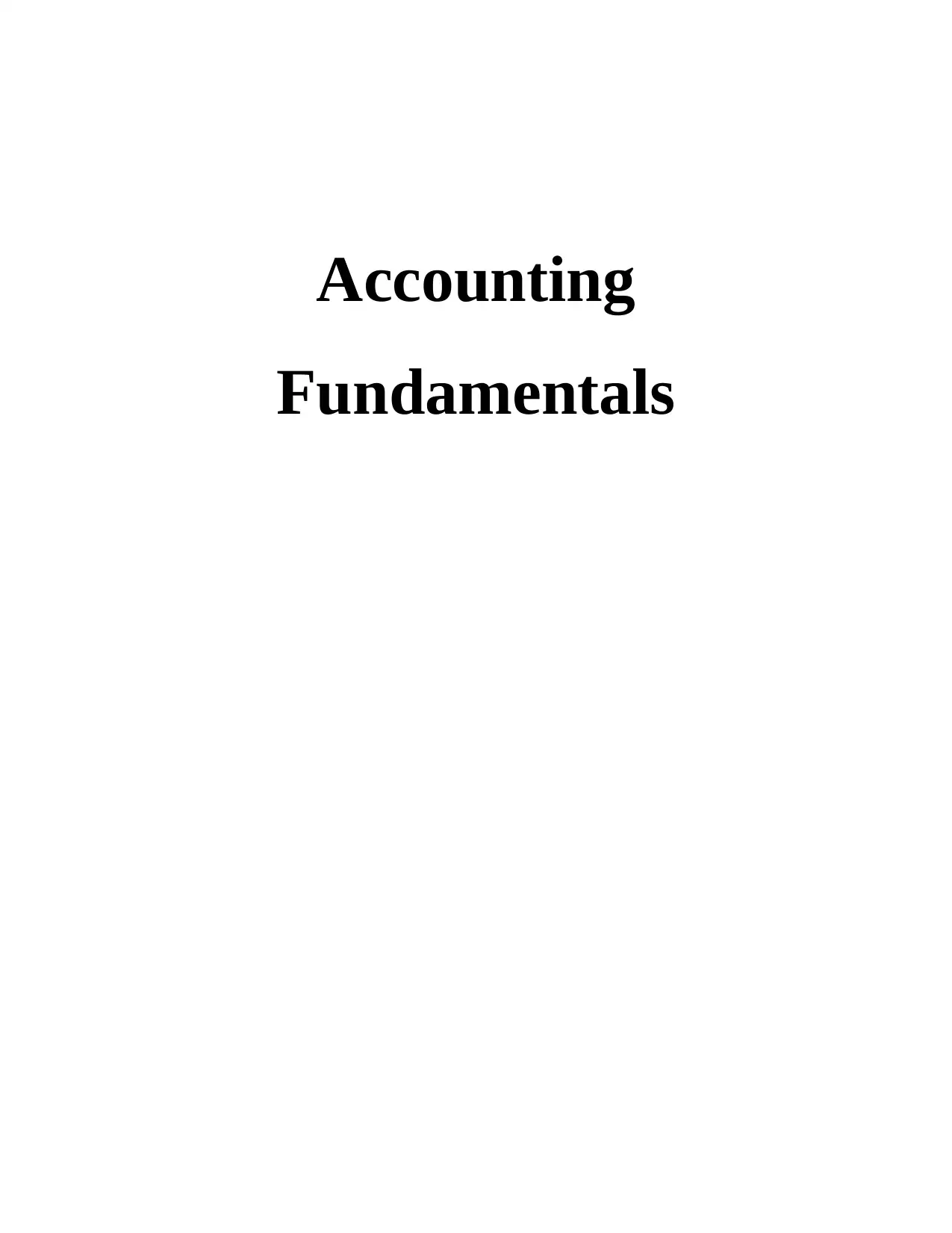
Accounting
Fundamentals
Fundamentals
Secure Best Marks with AI Grader
Need help grading? Try our AI Grader for instant feedback on your assignments.
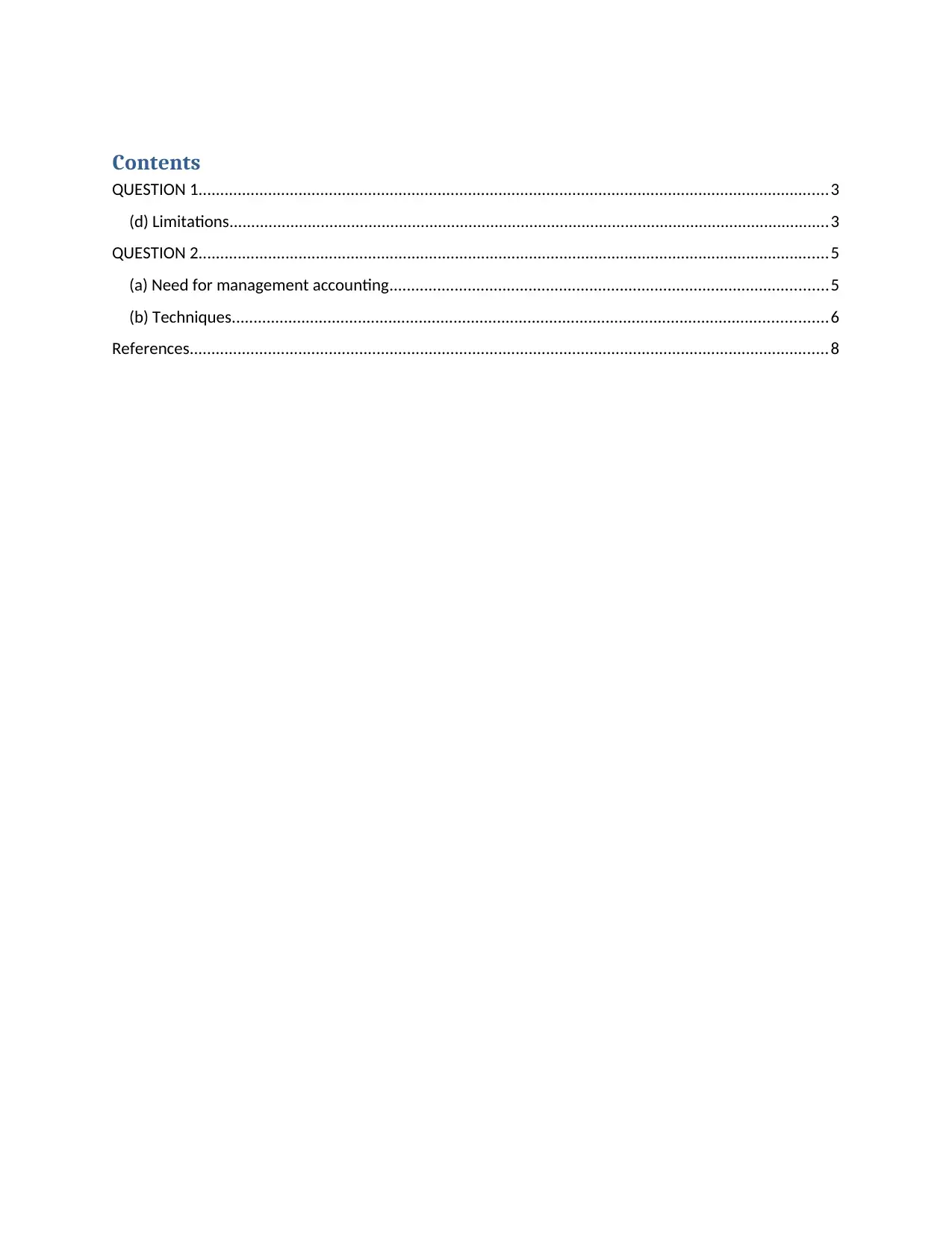
Contents
QUESTION 1.................................................................................................................................................3
(d) Limitations..........................................................................................................................................3
QUESTION 2.................................................................................................................................................5
(a) Need for management accounting.....................................................................................................5
(b) Techniques.........................................................................................................................................6
References...................................................................................................................................................8
QUESTION 1.................................................................................................................................................3
(d) Limitations..........................................................................................................................................3
QUESTION 2.................................................................................................................................................5
(a) Need for management accounting.....................................................................................................5
(b) Techniques.........................................................................................................................................6
References...................................................................................................................................................8
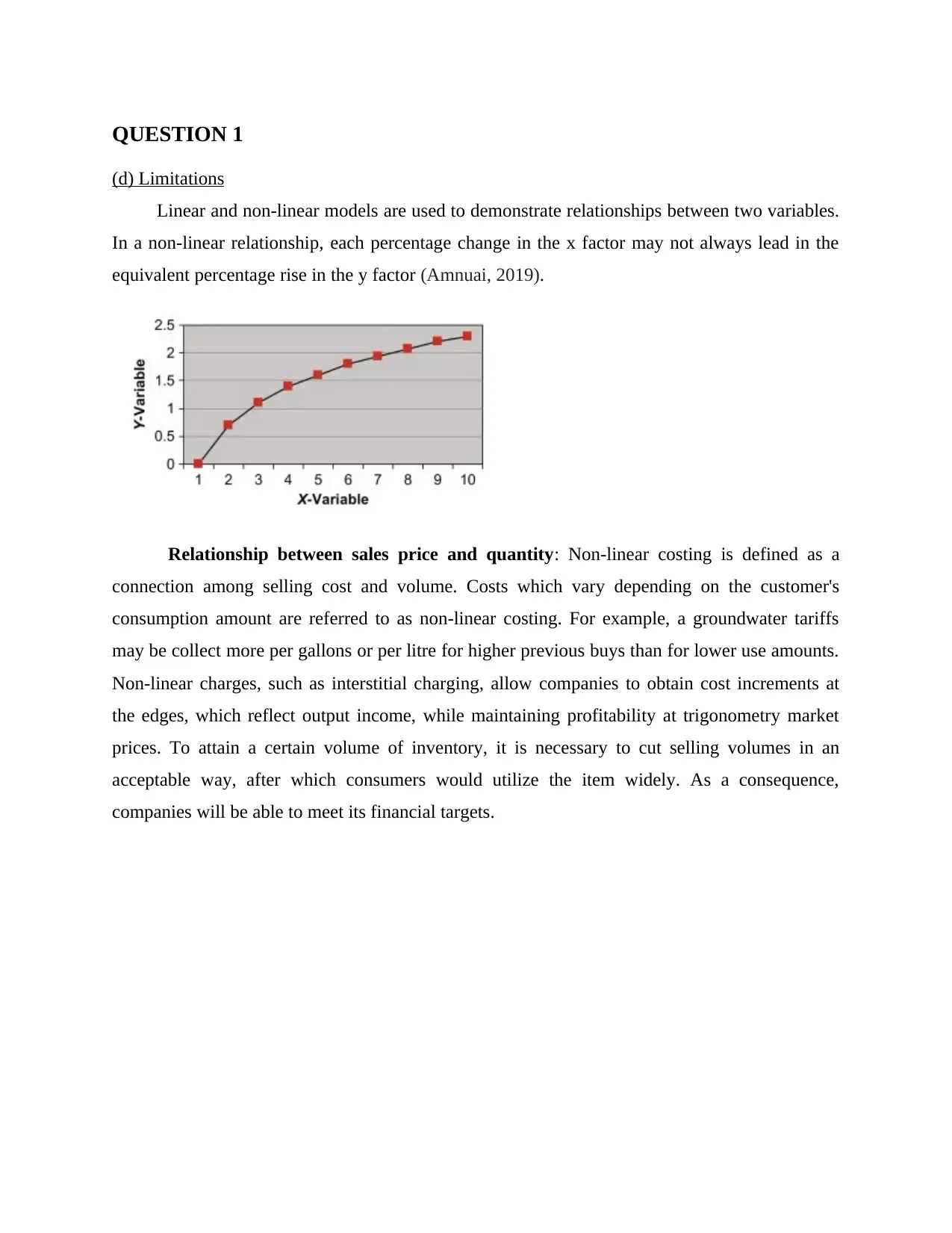
QUESTION 1
(d) Limitations
Linear and non-linear models are used to demonstrate relationships between two variables.
In a non-linear relationship, each percentage change in the x factor may not always lead in the
equivalent percentage rise in the y factor (Amnuai, 2019).
Relationship between sales price and quantity: Non-linear costing is defined as a
connection among selling cost and volume. Costs which vary depending on the customer's
consumption amount are referred to as non-linear costing. For example, a groundwater tariffs
may be collect more per gallons or per litre for higher previous buys than for lower use amounts.
Non-linear charges, such as interstitial charging, allow companies to obtain cost increments at
the edges, which reflect output income, while maintaining profitability at trigonometry market
prices. To attain a certain volume of inventory, it is necessary to cut selling volumes in an
acceptable way, after which consumers would utilize the item widely. As a consequence,
companies will be able to meet its financial targets.
(d) Limitations
Linear and non-linear models are used to demonstrate relationships between two variables.
In a non-linear relationship, each percentage change in the x factor may not always lead in the
equivalent percentage rise in the y factor (Amnuai, 2019).
Relationship between sales price and quantity: Non-linear costing is defined as a
connection among selling cost and volume. Costs which vary depending on the customer's
consumption amount are referred to as non-linear costing. For example, a groundwater tariffs
may be collect more per gallons or per litre for higher previous buys than for lower use amounts.
Non-linear charges, such as interstitial charging, allow companies to obtain cost increments at
the edges, which reflect output income, while maintaining profitability at trigonometry market
prices. To attain a certain volume of inventory, it is necessary to cut selling volumes in an
acceptable way, after which consumers would utilize the item widely. As a consequence,
companies will be able to meet its financial targets.
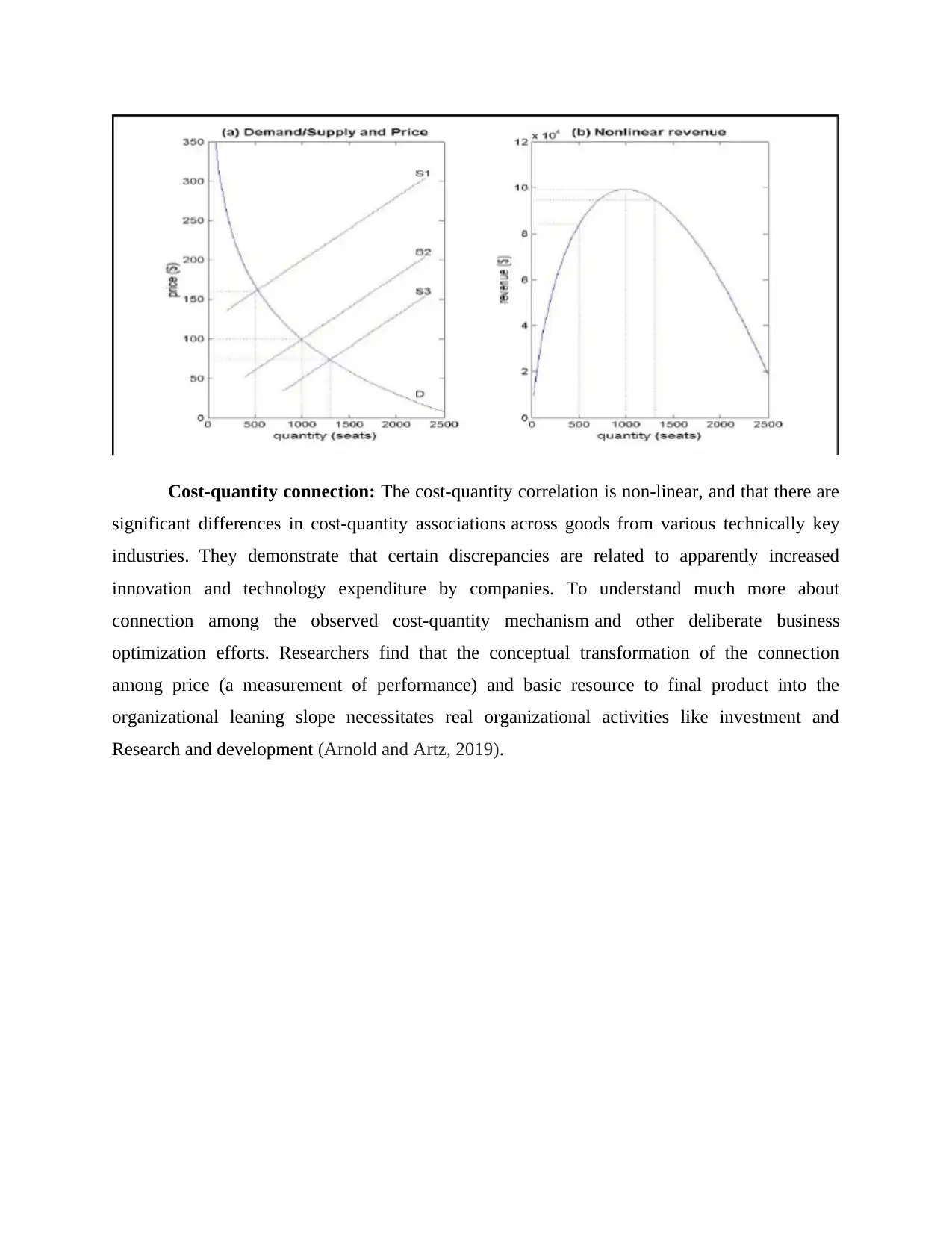
Cost-quantity connection: The cost-quantity correlation is non-linear, and that there are
significant differences in cost-quantity associations across goods from various technically key
industries. They demonstrate that certain discrepancies are related to apparently increased
innovation and technology expenditure by companies. To understand much more about
connection among the observed cost-quantity mechanism and other deliberate business
optimization efforts. Researchers find that the conceptual transformation of the connection
among price (a measurement of performance) and basic resource to final product into the
organizational leaning slope necessitates real organizational activities like investment and
Research and development (Arnold and Artz, 2019).
significant differences in cost-quantity associations across goods from various technically key
industries. They demonstrate that certain discrepancies are related to apparently increased
innovation and technology expenditure by companies. To understand much more about
connection among the observed cost-quantity mechanism and other deliberate business
optimization efforts. Researchers find that the conceptual transformation of the connection
among price (a measurement of performance) and basic resource to final product into the
organizational leaning slope necessitates real organizational activities like investment and
Research and development (Arnold and Artz, 2019).
Secure Best Marks with AI Grader
Need help grading? Try our AI Grader for instant feedback on your assignments.
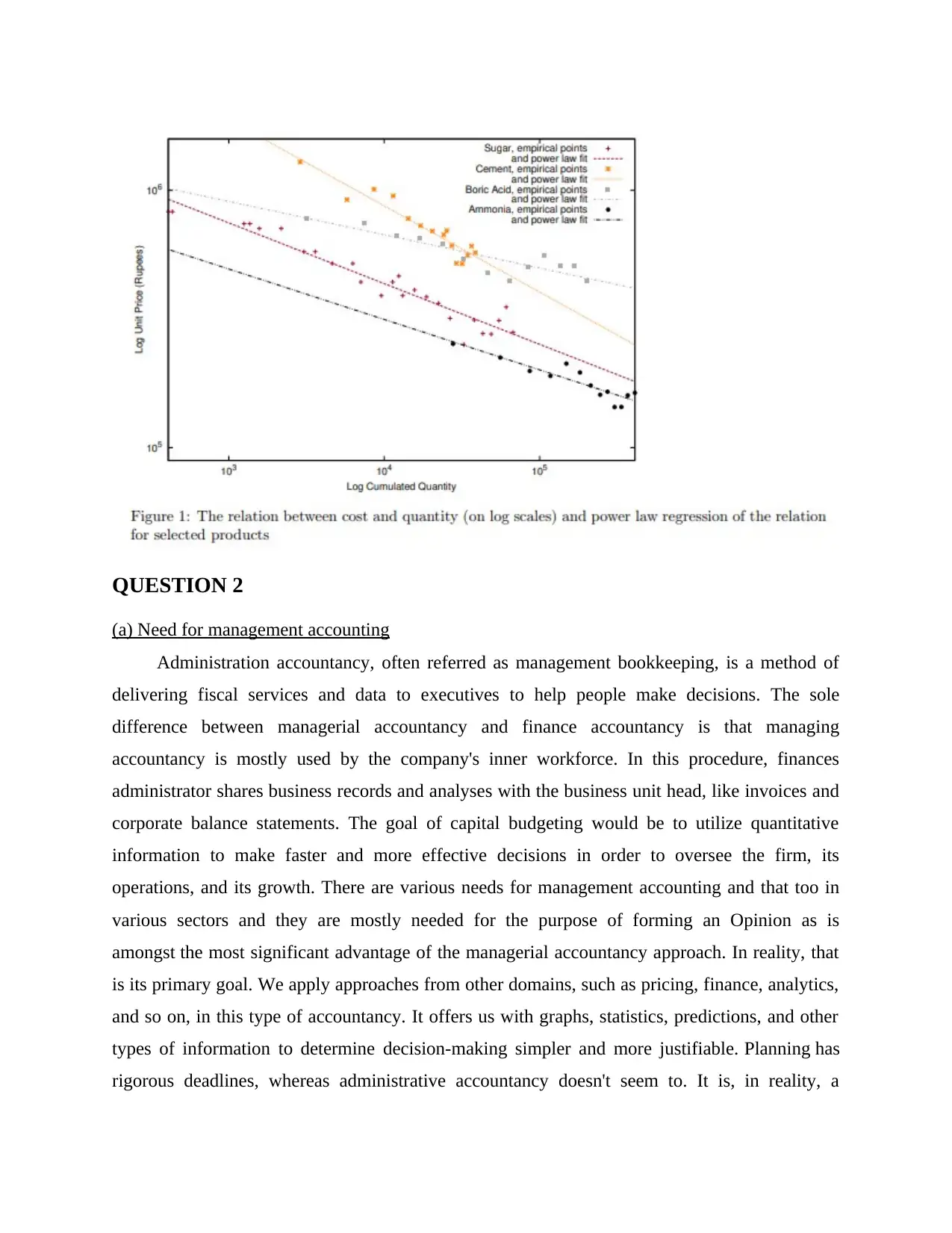
QUESTION 2
(a) Need for management accounting
Administration accountancy, often referred as management bookkeeping, is a method of
delivering fiscal services and data to executives to help people make decisions. The sole
difference between managerial accountancy and finance accountancy is that managing
accountancy is mostly used by the company's inner workforce. In this procedure, finances
administrator shares business records and analyses with the business unit head, like invoices and
corporate balance statements. The goal of capital budgeting would be to utilize quantitative
information to make faster and more effective decisions in order to oversee the firm, its
operations, and its growth. There are various needs for management accounting and that too in
various sectors and they are mostly needed for the purpose of forming an Opinion as is
amongst the most significant advantage of the managerial accountancy approach. In reality, that
is its primary goal. We apply approaches from other domains, such as pricing, finance, analytics,
and so on, in this type of accountancy. It offers us with graphs, statistics, predictions, and other
types of information to determine decision-making simpler and more justifiable. Planning has
rigorous deadlines, whereas administrative accountancy doesn't seem to. It is, in reality, a
(a) Need for management accounting
Administration accountancy, often referred as management bookkeeping, is a method of
delivering fiscal services and data to executives to help people make decisions. The sole
difference between managerial accountancy and finance accountancy is that managing
accountancy is mostly used by the company's inner workforce. In this procedure, finances
administrator shares business records and analyses with the business unit head, like invoices and
corporate balance statements. The goal of capital budgeting would be to utilize quantitative
information to make faster and more effective decisions in order to oversee the firm, its
operations, and its growth. There are various needs for management accounting and that too in
various sectors and they are mostly needed for the purpose of forming an Opinion as is
amongst the most significant advantage of the managerial accountancy approach. In reality, that
is its primary goal. We apply approaches from other domains, such as pricing, finance, analytics,
and so on, in this type of accountancy. It offers us with graphs, statistics, predictions, and other
types of information to determine decision-making simpler and more justifiable. Planning has
rigorous deadlines, whereas administrative accountancy doesn't seem to. It is, in reality, a
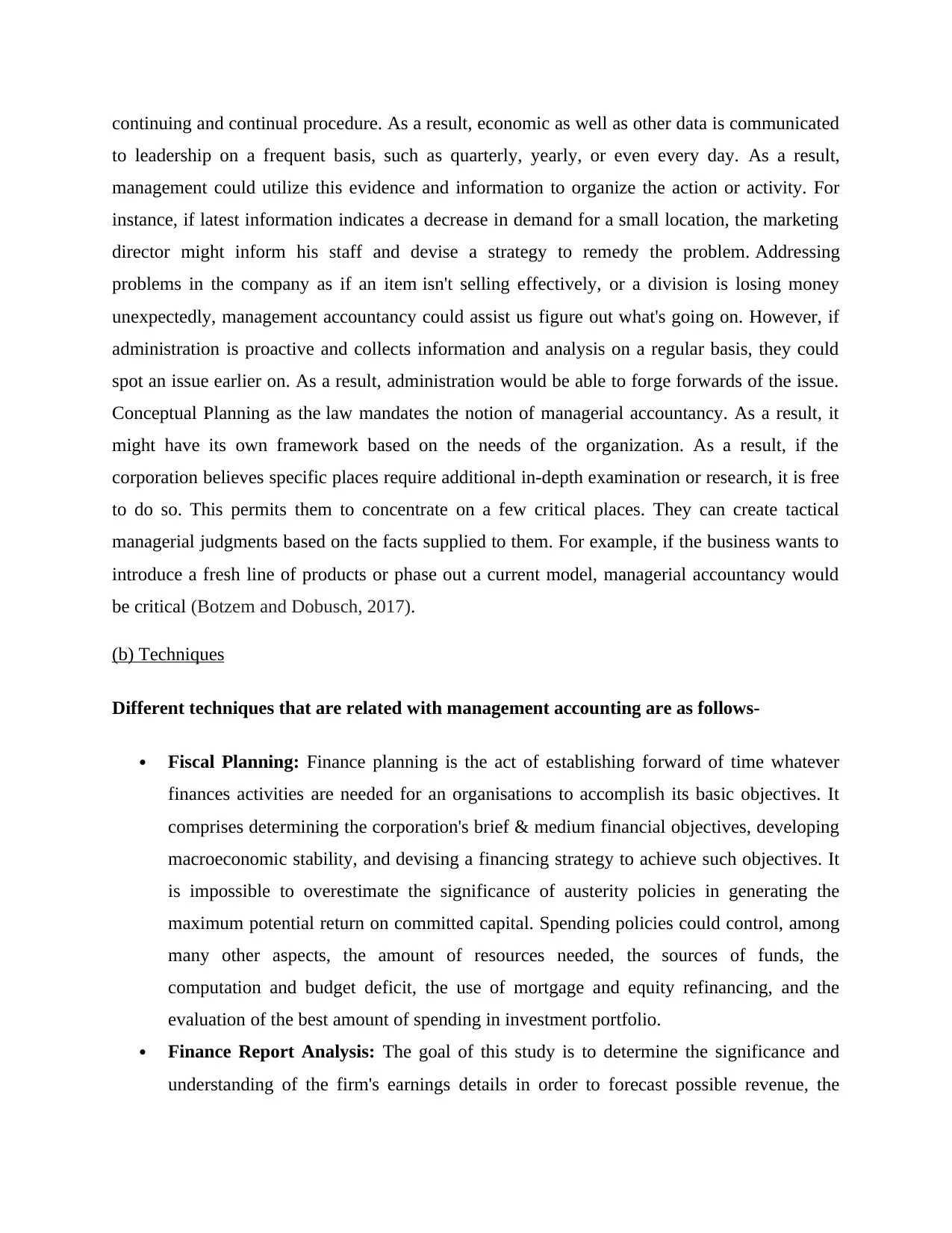
continuing and continual procedure. As a result, economic as well as other data is communicated
to leadership on a frequent basis, such as quarterly, yearly, or even every day. As a result,
management could utilize this evidence and information to organize the action or activity. For
instance, if latest information indicates a decrease in demand for a small location, the marketing
director might inform his staff and devise a strategy to remedy the problem. Addressing
problems in the company as if an item isn't selling effectively, or a division is losing money
unexpectedly, management accountancy could assist us figure out what's going on. However, if
administration is proactive and collects information and analysis on a regular basis, they could
spot an issue earlier on. As a result, administration would be able to forge forwards of the issue.
Conceptual Planning as the law mandates the notion of managerial accountancy. As a result, it
might have its own framework based on the needs of the organization. As a result, if the
corporation believes specific places require additional in-depth examination or research, it is free
to do so. This permits them to concentrate on a few critical places. They can create tactical
managerial judgments based on the facts supplied to them. For example, if the business wants to
introduce a fresh line of products or phase out a current model, managerial accountancy would
be critical (Botzem and Dobusch, 2017).
(b) Techniques
Different techniques that are related with management accounting are as follows-
Fiscal Planning: Finance planning is the act of establishing forward of time whatever
finances activities are needed for an organisations to accomplish its basic objectives. It
comprises determining the corporation's brief & medium financial objectives, developing
macroeconomic stability, and devising a financing strategy to achieve such objectives. It
is impossible to overestimate the significance of austerity policies in generating the
maximum potential return on committed capital. Spending policies could control, among
many other aspects, the amount of resources needed, the sources of funds, the
computation and budget deficit, the use of mortgage and equity refinancing, and the
evaluation of the best amount of spending in investment portfolio.
Finance Report Analysis: The goal of this study is to determine the significance and
understanding of the firm's earnings details in order to forecast possible revenue, the
to leadership on a frequent basis, such as quarterly, yearly, or even every day. As a result,
management could utilize this evidence and information to organize the action or activity. For
instance, if latest information indicates a decrease in demand for a small location, the marketing
director might inform his staff and devise a strategy to remedy the problem. Addressing
problems in the company as if an item isn't selling effectively, or a division is losing money
unexpectedly, management accountancy could assist us figure out what's going on. However, if
administration is proactive and collects information and analysis on a regular basis, they could
spot an issue earlier on. As a result, administration would be able to forge forwards of the issue.
Conceptual Planning as the law mandates the notion of managerial accountancy. As a result, it
might have its own framework based on the needs of the organization. As a result, if the
corporation believes specific places require additional in-depth examination or research, it is free
to do so. This permits them to concentrate on a few critical places. They can create tactical
managerial judgments based on the facts supplied to them. For example, if the business wants to
introduce a fresh line of products or phase out a current model, managerial accountancy would
be critical (Botzem and Dobusch, 2017).
(b) Techniques
Different techniques that are related with management accounting are as follows-
Fiscal Planning: Finance planning is the act of establishing forward of time whatever
finances activities are needed for an organisations to accomplish its basic objectives. It
comprises determining the corporation's brief & medium financial objectives, developing
macroeconomic stability, and devising a financing strategy to achieve such objectives. It
is impossible to overestimate the significance of austerity policies in generating the
maximum potential return on committed capital. Spending policies could control, among
many other aspects, the amount of resources needed, the sources of funds, the
computation and budget deficit, the use of mortgage and equity refinancing, and the
evaluation of the best amount of spending in investment portfolio.
Finance Report Analysis: The goal of this study is to determine the significance and
understanding of the firm's earnings details in order to forecast possible revenue, the
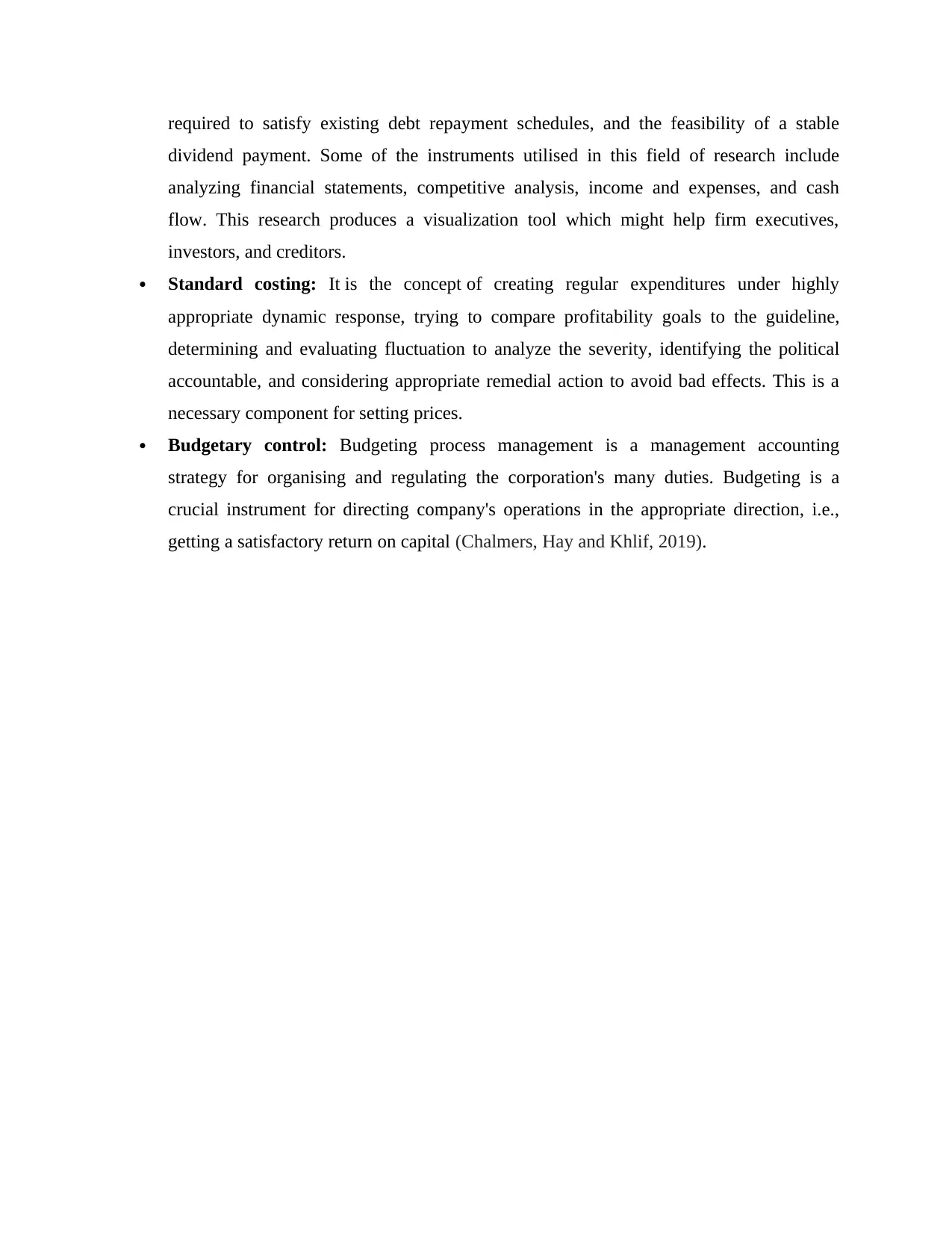
required to satisfy existing debt repayment schedules, and the feasibility of a stable
dividend payment. Some of the instruments utilised in this field of research include
analyzing financial statements, competitive analysis, income and expenses, and cash
flow. This research produces a visualization tool which might help firm executives,
investors, and creditors.
Standard costing: It is the concept of creating regular expenditures under highly
appropriate dynamic response, trying to compare profitability goals to the guideline,
determining and evaluating fluctuation to analyze the severity, identifying the political
accountable, and considering appropriate remedial action to avoid bad effects. This is a
necessary component for setting prices.
Budgetary control: Budgeting process management is a management accounting
strategy for organising and regulating the corporation's many duties. Budgeting is a
crucial instrument for directing company's operations in the appropriate direction, i.e.,
getting a satisfactory return on capital (Chalmers, Hay and Khlif, 2019).
dividend payment. Some of the instruments utilised in this field of research include
analyzing financial statements, competitive analysis, income and expenses, and cash
flow. This research produces a visualization tool which might help firm executives,
investors, and creditors.
Standard costing: It is the concept of creating regular expenditures under highly
appropriate dynamic response, trying to compare profitability goals to the guideline,
determining and evaluating fluctuation to analyze the severity, identifying the political
accountable, and considering appropriate remedial action to avoid bad effects. This is a
necessary component for setting prices.
Budgetary control: Budgeting process management is a management accounting
strategy for organising and regulating the corporation's many duties. Budgeting is a
crucial instrument for directing company's operations in the appropriate direction, i.e.,
getting a satisfactory return on capital (Chalmers, Hay and Khlif, 2019).
Paraphrase This Document
Need a fresh take? Get an instant paraphrase of this document with our AI Paraphraser
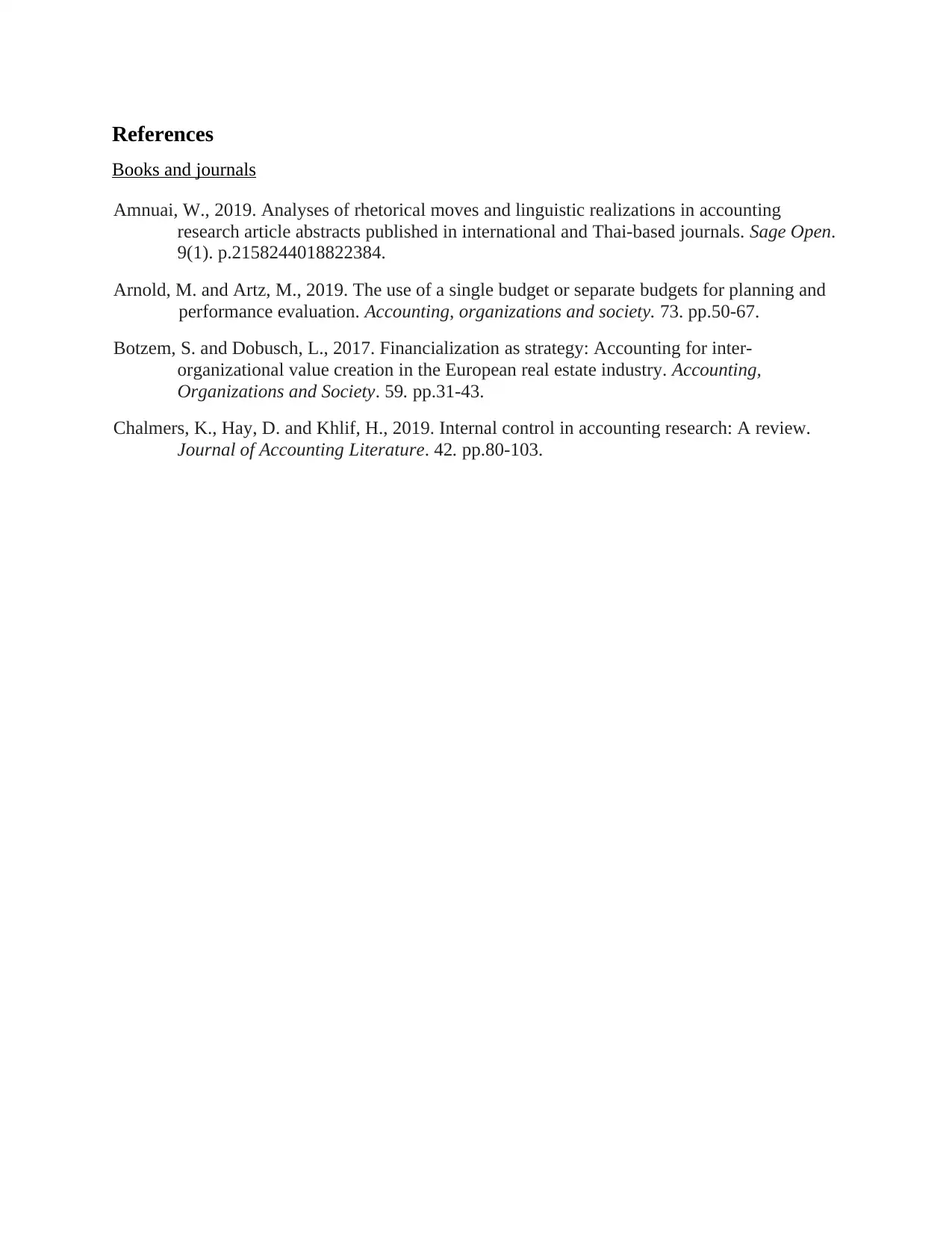
References
Books and journals
Amnuai, W., 2019. Analyses of rhetorical moves and linguistic realizations in accounting
research article abstracts published in international and Thai-based journals. Sage Open.
9(1). p.2158244018822384.
Arnold, M. and Artz, M., 2019. The use of a single budget or separate budgets for planning and
performance evaluation. Accounting, organizations and society. 73. pp.50-67.
Botzem, S. and Dobusch, L., 2017. Financialization as strategy: Accounting for inter-
organizational value creation in the European real estate industry. Accounting,
Organizations and Society. 59. pp.31-43.
Chalmers, K., Hay, D. and Khlif, H., 2019. Internal control in accounting research: A review.
Journal of Accounting Literature. 42. pp.80-103.
Books and journals
Amnuai, W., 2019. Analyses of rhetorical moves and linguistic realizations in accounting
research article abstracts published in international and Thai-based journals. Sage Open.
9(1). p.2158244018822384.
Arnold, M. and Artz, M., 2019. The use of a single budget or separate budgets for planning and
performance evaluation. Accounting, organizations and society. 73. pp.50-67.
Botzem, S. and Dobusch, L., 2017. Financialization as strategy: Accounting for inter-
organizational value creation in the European real estate industry. Accounting,
Organizations and Society. 59. pp.31-43.
Chalmers, K., Hay, D. and Khlif, H., 2019. Internal control in accounting research: A review.
Journal of Accounting Literature. 42. pp.80-103.
1 out of 8
Related Documents
Your All-in-One AI-Powered Toolkit for Academic Success.
+13062052269
info@desklib.com
Available 24*7 on WhatsApp / Email
![[object Object]](/_next/static/media/star-bottom.7253800d.svg)
Unlock your academic potential
© 2024 | Zucol Services PVT LTD | All rights reserved.





